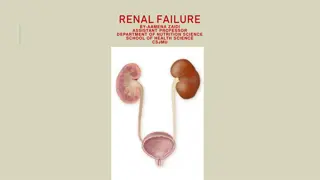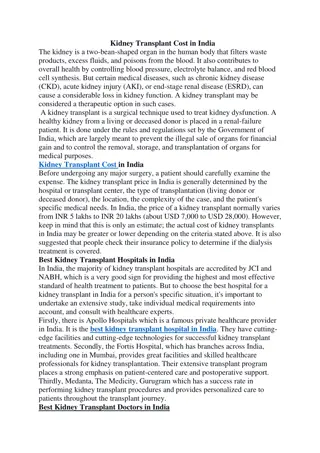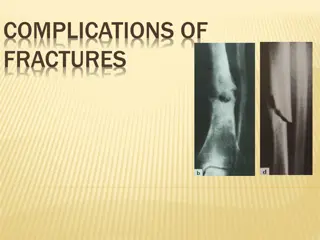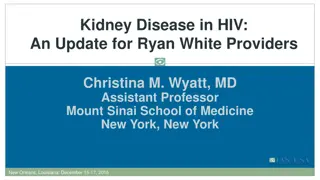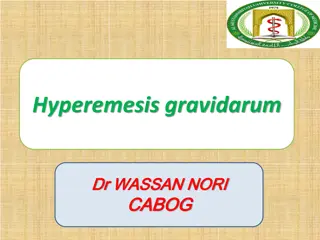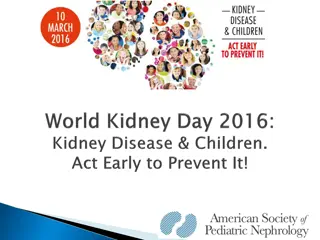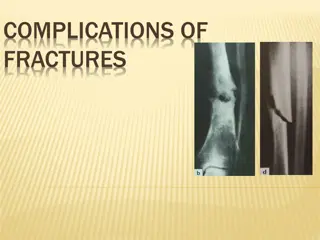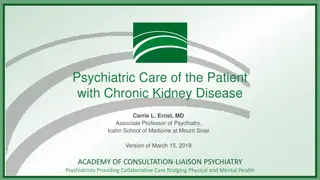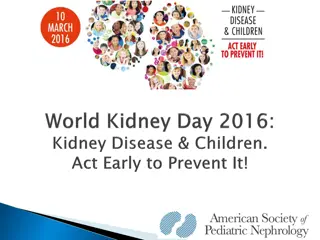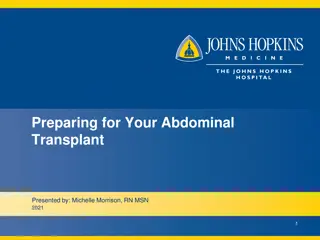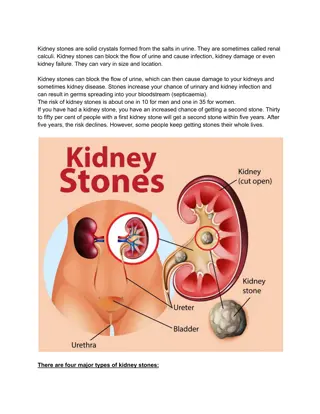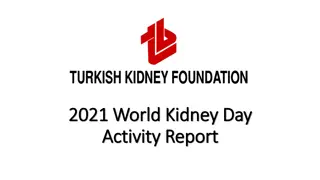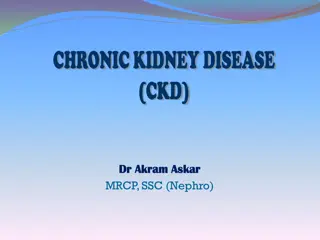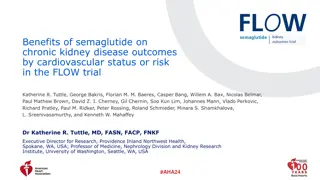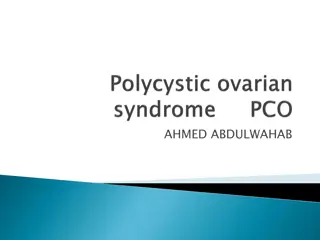Polycystic Kidney Disease: Symptoms, Types, Complications
Polycystic kidney disease (PKD) is an inherited disorder leading to cyst formation in the kidneys and sometimes the liver. Learn about its symptoms, types, complications, and treatment options to manage this condition effectively.
Download Presentation

Please find below an Image/Link to download the presentation.
The content on the website is provided AS IS for your information and personal use only. It may not be sold, licensed, or shared on other websites without obtaining consent from the author.If you encounter any issues during the download, it is possible that the publisher has removed the file from their server.
You are allowed to download the files provided on this website for personal or commercial use, subject to the condition that they are used lawfully. All files are the property of their respective owners.
The content on the website is provided AS IS for your information and personal use only. It may not be sold, licensed, or shared on other websites without obtaining consent from the author.
E N D
Presentation Transcript
StudyMafia.Org Polycystic Kidney Disease(PKD) Submitted Studymafia.org Studymafia.org Submitted To: To: Submitted Submitted By: By: Studymafia.org Studymafia.org
Table Contents Definition Introduction Symptoms of PKD Types of PKD Complications of PKD Prevention of PKD Treatment of PKD Conclusion 2
Definition Polycystic kidney disease (PKD) is an inherited disorder in which clusters of cysts develop primarily within your kidneys, causing your kidneys to enlarge and lose function over time. 3
Introduction Polycystic kidney disease can also cause cysts to develop in your liver and elsewhere in your body. The disease can cause serious complications, including high blood pressure and kidney failure. PKD varies greatly in its severity, and some complications are preventable. Lifestyle changes and treatments might help reduce damage to your kidneys from complications. 4
Types of PKD Autosomal dominant polycystic kidney disease (ADPKD). Signs and symptoms of ADPKD often develop between the ages of 30 and 40. In the past, this type was called adult polycystic kidney disease, but children can develop the disorder. 6
Types of PKD Autosomal recessive polycystic kidney disease (ARPKD). This type is far less common than is ADPKD. The signs and symptoms often appear shortly after birth. Sometimes, symptoms don't appear until later in childhood or during adolescence. 7
Complications of PKD High blood pressure. Elevated blood pressure is a common complication of polycystic kidney disease. Untreated, high blood pressure can cause further damage to your kidneys and increase your risk of heart disease and strokes. 8
Complications of PKD Loss of kidney function. Progressive loss of kidney function is one of the most serious complications of polycystic kidney disease. Nearly half of those with the disease have kidney failure by age 60. 9
Complications of PKD Chronic pain. Pain is a common symptom for people with polycystic kidney disease. It often occurs in your side or back. The pain can also be associated with a urinary tract infection, a kidney stone or a malignancy. 10
Complications of PKD Growth of cysts in the liver. The likelihood of developing liver cysts for someone with polycystic kidney disease increases with age. While both men and women develop cysts, women often develop larger cysts. Female hormones and multiple pregnancies might contribute to liver cyst development. 11
Complications of PKD Development of an aneurysm in the brain. A balloon-like bulge in a blood vessel (aneurysm) in your brain can cause bleeding (hemorrhage) if it ruptures. People with polycystic kidney disease have a higher risk of aneurysms 12
Complications of PKD Pregnancy complications. Pregnancy is successful for most women with polycystic kidney disease. In some cases, however, women may develop a life- threatening disorder called preeclampsia. Those most at risk have high blood pressure or a decline in kidney function before they become pregnant. 13
Complications of PKD Heart valve abnormalities. As many as 1 in 4 adults with polycystic kidney disease develops mitral valve prolapse. When this happens, the heart valve no longer closes properly, which allows blood to leak backward. 14
Complications of PKD Colon problems. Weaknesses and pouches or sacs in the wall of the colon (diverticulosis) may develop in people with polycystic kidney disease. 15
Prevention of PKD If you have polycystic kidney disease and you're considering having children, a genetic counselor can help you assess your risk of passing the disease to your offspring. Keeping your kidneys as healthy as possible may help prevent some of the complications of this disease. One of the most important ways you can protect your kidneys is by managing your blood pressure. 16
Prevention of PKD Take the blood pressure medications prescribed by your doctor as directed. Eat a low-salt diet containing plenty of fruits, vegetables and whole grains. Maintain a healthy weight. Ask your doctor what the right weight is for you. If you smoke, quit. Exercise regularly. Aim for at least 30 minutes of moderate physical activity most days of the week. Limit alcohol use. 17
Treatment of PKD Kidney cyst growth. Tolvaptan therapy may be recommended for adults at risk of rapidly progressive ADPKD. Tolvaptan (Jynarque, Samsca) is a pill that you take by mouth that works to slow the rate of kidney cyst growth and the decline in how well your kidneys work. 18
Treatment of PKD High blood pressure. Controlling high blood pressure can delay the progression of the disease and slow further kidney damage. Combining a low-sodium, low- fat diet that's moderate in protein and calorie content with not smoking, increasing exercise and reducing stress may help control high blood pressure. 19
Treatment of PKD Declining kidney function. To help your kidneys stay as healthy as possible for as long as possible, experts recommend maintaining a normal body weight (body mass index). Drinking water and fluids throughout the day may help slow the growth of kidney cysts, which in turn could slow down a decline in kidney function. 20
Treatment of PKD Pain. You might be able to control the pain of polycystic kidney disease with over-the- counter medications containing acetaminophen. For some people, however, the pain is more severe and constant. 21
Treatment of PKD Bladder or kidney infections. Prompt treatment of infections with antibiotics is necessary to prevent kidney damage. Your doctor may investigate whether you have a simple bladder infection or a more complicated cyst or kidney infection. 22
Treatment of PKD Blood in the urine. You'll need to drink lots of fluids, preferably plain water, as soon as you notice blood in your urine to dilute the urine. Dilution might help prevent obstructive clots from forming in your urinary tract. 23
Treatment of PKD Kidney failure. If your kidneys lose their ability to remove waste products and extra fluids from your blood, you'll eventually need either dialysis or a kidney transplant. Seeing your doctor regularly for monitoring of PKD allows for the best timing of a kidney transplant 24
Conclusion Polycystic kidney disease (PKD) is an inherited disorder in which clusters of cysts develop primarily within your kidneys, causing your kidneys to enlarge and lose function over time. Cysts are noncancerous round sacs containing fluid. The cysts vary in size, and they can grow very large 26


